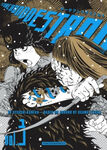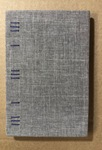
FINALLY! Twenty years after Connie left Will at home to get takeout and a video (yes, that's right, she left to go to the video rental store – that's how long ago it was) – the dénouement!
Keeping Two collects the entirety of the extant series along with the highly anticipated conclusion. The book itself is a beautifully designed hardcover, with rounded edges, and the 300+ pages of classic Jordan Crane artwork is crsiply printed entirely in shades of green – from so dark as to be nearly black all the way through to shades so light as to be nearly translucent, all on heavy, flat, off-white stock. A real pleasure to hold and to read.
For those unfamiliar with the premise, Will is not someone who waits well. His mind is always going, and, not only that, it tends to head for dark places, the places where things go badly. Even when he tries to shut his racing mind down – or at least redirect it along the predetermined path of a novel – his choice of reading – which, as readers of this work will discover, is shared by Connie – is, at least in the instance covered here, of a book where things don't go well for the protagonists. Thus the "taking two" of the title (as in, "it takes two to tango") is multivalent and multilayered. The bulk of Taking Two is devoted to Will's imaginings – both of what has transpired with Connie that has prevented her from returning home when he expected, and what is happening with the protagonists – another couple – in the novel he is reading, and then how the two intertwine. There is then, of course, the additional layer provided by the readers of Taking Two themselves, whose own lives are then intertwining with that of these two couples, one nested within the other. So, perhaps, the ideal readers of this work would be other couples who read Taking Two by taking turns... Ultimately, the book leads out of the darkness and towards survival and redemption, but not without multiple crises and climaxes along the way. It's a roller coaster ride of a read!
For more details and insights into Crane's ambitions with the work, check out Rachel Cooke's review in The Guardian, HERE.





















